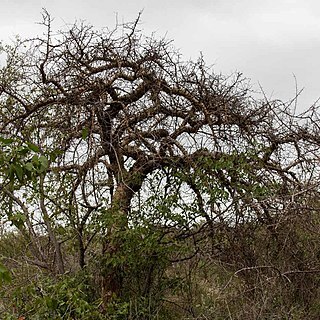Small unarmed tree with a spreading crown and an ill-defined, often fluted trunk, up to 8 m. tall; bark grey; exudate not scented.. Leaves 5–13-foliolate, up to 13 cm. long; petiole well developed, longer than the terminal leaflet; leaflets entire, pubescent beneath and more sparsely so above, usually rather coriaceous when mature; lateral leaflets elliptic, rounded or acute at the base, rounded or acuminate apically, 10–50 mm. long, 8–20 mm. wide, the terminal leaflet rather larger, cuneate-obovate.. Inflorescence and flowers as in C. mildbraedii; fruit rather shorter, 9–12 × 9–10 × (3 + 4.5) mm., usually densely pubescent, occasionally subglabrous; arms of the pseudaril usually rather shorter.. Fig. 9/5.
A small to medium sized tree. It grows to 8-12 m high. The leaves have 2-6 pairs of leaflets and one at the end. The lower pair are smaller. The flowers are small and yellow to pinkish. They are in clusters in the axils of leaves. The fruit are almost round and 10 mm across. They are densely furry. They are green becoming red. The base of the stone is covered with a flat, scarlet false seed layer with 4 wings.
Leaves pinnate; petiole up to 5 cm. long, densely pubescent; leaflets 2–6-jugate, lamina up to 6 × 3 cm., elliptic or oblong-elliptic, apex acute or obtuse, margin entire, base rounded or broadly cuneate (terminal leaflet always cuneate), pubescent on both surfaces, sometimes distinctly paler and tomentose below; petiolules c. 0·5 mm., densely pubescent.
Tree, up to 8 m high. Branchlets and leaves pilose to tomentose. Leaves imparipinnate; leaflets elliptic, oblong-elliptic or obovate, often distinctly paler below, margins entire. Disc of flower 4-lobed. Pseudo-aril with 4 winged arms. Flowers green to red.
Flowers appearing before the leaves or with the young leaves in clustered axillary dichasial cymes up to c. 2 cm. long; branches of inflorescence pubescent; pedicels slender, c. 2 mm. long; bracteoles caducous, c. 2 mm. long, subulate, brown, pubescent.
Small tree up to c. 8 m. tall; trunk often fluted; bark smooth, dark greenish or dark grey; young branches densely pubescent, sometimes spiny.
Fruit c. 1·1 × 0·9 cm., ellipsoid, densely pubescent; pseudaril with 4 arms; endocarp c. 9 × 8 mm., smooth, both faces deeply convex.
Calyx c. 2·5 mm. long, campanulate, lobed at least half-way, densely pubescent.
Petals up to 5 mm. long, pubescent at the back except towards the edges.
Stamen-filaments slender, subterete.
Disk 4-lobed.


